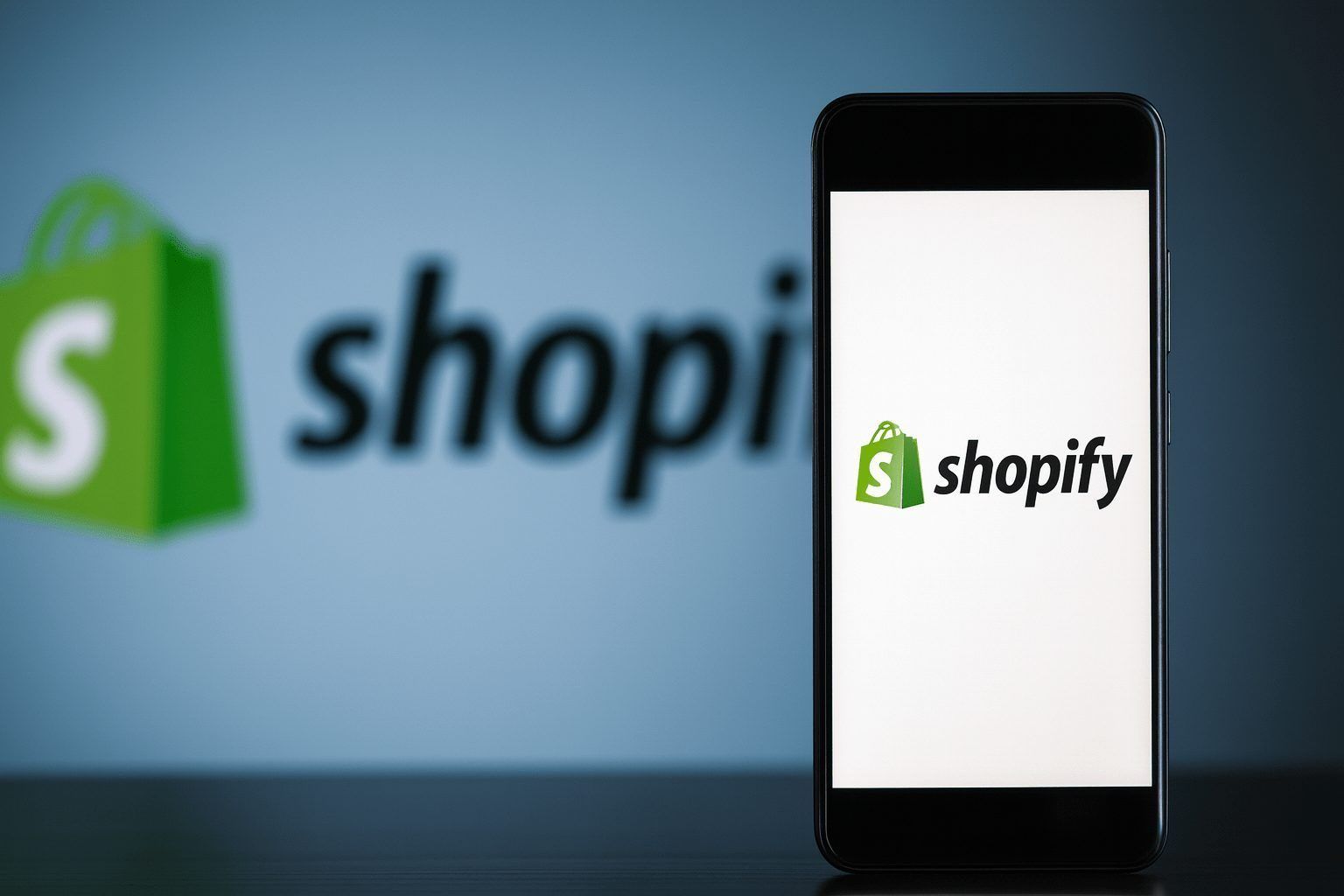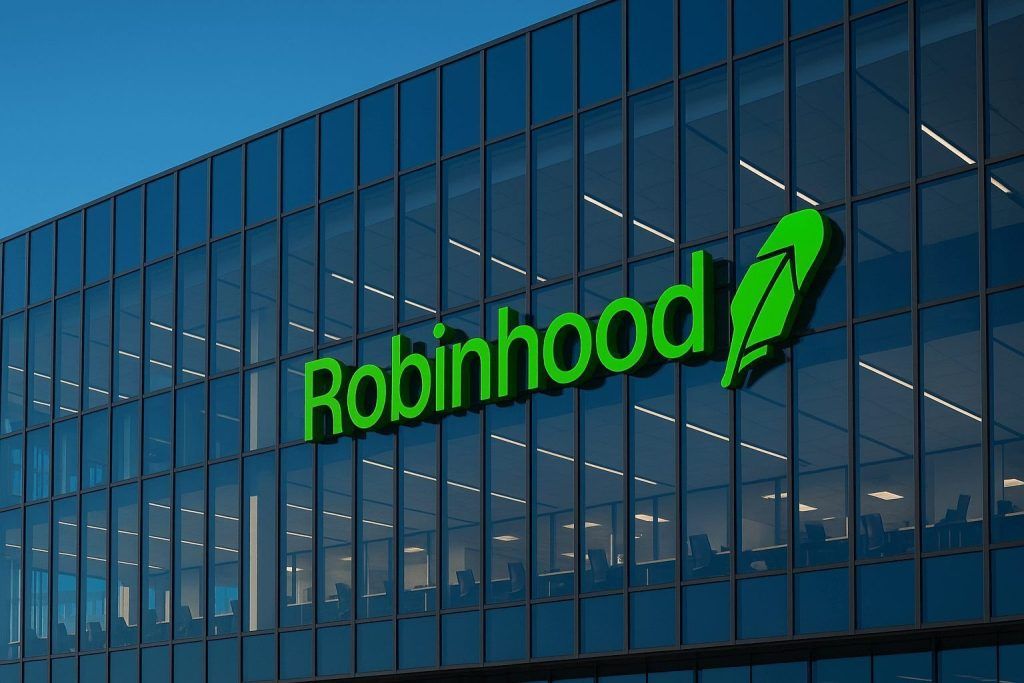Data as of U.S. market close on Friday, November 21, 2025. This article is for information only and is not financial advice.
Key Takeaways
- Shopify stock today: Shopify (NASDAQ: SHOP) closed Friday at $147.80, up 2.24% on the day, after trading between $142.43 and $149.88 on volume of just over 10 million shares. [1]
- Position vs recent history: Shares are now about 5.6% below their 50‑day moving average, but roughly 10.6% above the 200‑day trend line and around 19% below the 52‑week high near $182. [2]
- Fundamentals: Q3 2025 revenue climbed about 31–32% year over year to roughly $2.84 billion, while gross merchandise volume (GMV) also grew about 32% to around $92 billion, with free cash flow margin near 18%. [3]
- AI & partnerships: Shopify says traffic from AI tools is up 7x since January and AI‑driven orders are 11x higher, supported by an OpenAI (ChatGPT) partnership and a new Visualsoft deal aimed at unifying online and in‑store shopping. [4]
- Valuation & Wall Street: At about 18× sales and roughly 108× trailing earnings, Shopify trades at a steep premium to the market; analysts’ 12‑month targets mostly cluster in the mid‑$160s to mid‑$170s, implying moderate upside from current levels. [5]
Shopify stock today: Weekend snapshot after Friday’s rally
Although U.S. markets are closed this Saturday (November 22, 2025), Shopify stock today is effectively pegged to Friday’s close:
- Last close: $147.80
- Daily change: +$3.24 (+2.24%)
- Intraday range: $142.43 – $149.88
- Volume: ~10.3 million shares [6]
That move capped a strong week: from Monday’s close near $139.93 to Friday’s $147.80, Shopify gained roughly 5.6%, outpacing most major indices. [7]
From a technical perspective, the picture is mixed:
- 52‑week range: $69.84 – $182.19
- 50‑day moving average: ~$156.65 (SHOP is ~5.6% below this)
- 200‑day moving average: ~$133.64 (SHOP is ~10.6% above this) [8]
In other words, Shopify has pulled back from its early‑October highs but remains firmly in an uptrend on a longer‑term basis, with the stock still well above its 200‑day line.
Volatility remains elevated: one analysis counts 26 moves greater than 5% over the last year, underlining that SHOP continues to trade like a high‑growth, high‑beta tech name. [9]
Why Shopify shares climbed on Friday
Friday’s gain didn’t happen in a vacuum. A broader software and growth‑stock rebound followed comments from New York Fed President John Williams that boosted odds of a December rate cut, easing pressure on long‑duration tech valuations. [10]
Within that move:
- A StockStory/Finviz recap notes that Shopify jumped close to 3% in the afternoon session as lower yields helped growth stocks rebound. [11]
- The same report highlights that Shopify is still trading well below its recent highs despite being up roughly 37% year‑to‑date, reinforcing the idea that investors are selectively bidding up quality growth stories after a choppy autumn. [12]
The near‑term bull case on Friday essentially blended macro relief (rate‑cut hopes) with company‑specific momentum coming out of strong Q3 results and new commerce partnerships.
Q3 2025 recap: Fast growth, but margin questions
Shopify’s third‑quarter 2025 numbers, released on November 4, are still the backbone of today’s valuation debate.
Top‑line strength
Across multiple sources, the broad picture is consistent:
- Revenue: Around $2.84 billion, up about 31–32% year over year, beating analyst estimates of roughly $2.75–$2.76 billion. [13]
- GMV: Approximately $92 billion, also up about 32% versus a year earlier, indicating strong transaction growth on the platform. [14]
- Free cash flow margin: Roughly 18%, marking nine consecutive quarters of double‑digit free‑cash‑flow margins according to Shopify’s own release. [15]
Shopify’s management has framed Q3 as one of its strongest quarters yet, with President Harley Finkelstein highlighting the company’s ability to deliver simultaneous growth and profitability heading into peak holiday season. [16]
EPS: A noisy picture
Earnings per share are trickier because different outlets use slightly different (GAAP vs non‑GAAP) numbers:
- MarketBeat cites $0.27 per share, beating a $0.24 consensus. [17]
- Zacks/Finviz references EPS around $0.34, matching its consensus estimate. [18]
- CoinCentral highlights GAAP EPS of $0.20, below a $0.25 forecast, while pointing out that adjusted EPS still came in above expectations. [19]
- Investing.com’s earnings summary shows EPS of about $0.345 vs $0.335 forecast. [20]
The takeaway: revenue and cash flow clearly beat, while EPS depends on which definition you look at—one reason why the immediate post‑earnings stock reaction was choppy.
Margins and spending
The bullish growth story is partially offset by narrowing margins:
- Reuters reports that gross margin slipped to about 48.9% from 51.7% a year earlier, mainly due to sharply higher operating expenses, including ~25%+ growth in AI and marketing spend. [21]
- Net income dropped to about $264 million from $828 million in the prior‑year quarter, despite the strong top‑line performance. [22]
Investors initially focused on those cost pressures; Shopify shares fell roughly 3–4% immediately after the earnings release, even with an upbeat revenue outlook. [23]
Q4 and full‑year outlook
Management remains optimistic about the holidays:
- Shopify guides Q4 2025 revenue growth in the mid‑to‑high‑20s percent range year over year, above LSEG’s consensus of about 23–24%. [24]
- Zacks notes consensus current‑quarter sales of roughly $3.58 billion (+27.1% YoY) and full‑year revenue of around $11.44 billion (+28.8%), with 2026 revenue expected to grow about 22% to nearly $13.94 billion. [25]
These numbers underpin the market’s willingness to tolerate elevated multiples—provided Shopify can eventually let margins expand again once the current investment cycle in AI and go‑to‑market slows.
AI, ChatGPT and the Visualsoft partnership: The strategic story
For Shopify stock, the real long‑term driver isn’t just quarterly beats; it’s the company’s push to be the default commerce infrastructure in an AI‑first, omnichannel world.
AI traffic and shopping agents
On the Q3 call and in subsequent coverage:
- Shopify said traffic from AI tools to its merchants’ stores is up about 7× since January, while AI‑driven orders are up roughly 11×. [26]
- The company has partnered with OpenAI, enabling shoppers to discover and buy products via ChatGPT, and is also experimenting with Perplexity and Microsoft Copilot integrations. [27]
- Shopify executives described AI not as a feature but as central” to the way the company builds products and makes decisions, with internal tools like Scout analyzing huge volumes of merchant feedback. [28]
That framing aligns with broader e‑commerce industry trends: Shopify’s own blog and external research highlight AI‑driven personalization, pricing, and automation as key to future online retail growth. [29]
Sidekick and merchant productivity
Shopify’s Sidekick AI assistant is becoming a front‑line tool for merchants, helping automate tasks such as setting up discounts, generating reports, and answering how do I…?” operational questions directly inside the admin. Reuters notes that Sidekick is quickly becoming the default way merchants get things done” on the platform, especially for small and mid‑sized businesses. [30]
For investors, Sidekick and related tools matter because they increase switching costs and deepen Shopify’s role as core operating system rather than just a storefront builder.
Visualsoft: Bridging online and in‑store retail
Another fresh catalyst this week is Shopify’s new partnership with Visualsoft, a UK‑focused retail tech firm:
- Visualsoft and Shopify jointly published research showing that about 88% of UK shoppers already buy both online and in‑store from the same retailers, underscoring how normal omnichannel shopping has become. [31]
- The collaboration aims to unify Shopify’s POS platform with Visualsoft’s expertise in physical retail, giving merchants a single view of inventory, customer data, and loyalty across channels. [32]
StockStory notes that news of this partnership helped lift Shopify shares about 2% earlier in the week, as investors warmed to the idea of Shopify as a leader in connected retail experiences, not just e‑commerce. [33]
Taken together with Shopify’s earlier spike to record highs on the Toronto Stock Exchange—helped in part by enthusiasm for AI‑adjacent plays and the OpenAI/ChatGPT integration—the Visualsoft deal reinforces the narrative that Shopify is one of the purest long‑term bets on omnichannel commerce plus AI. [34]
Institutional flows and analyst sentiment
Hedge funds and institutions
Recent filings highlight a mix of profit‑taking and new buying:
- Mediolanum International Funds cut its Shopify position by about 17% in Q2, selling 22,932 shares and ending the quarter with roughly 110,000 shares worth around $12.5 million. [35]
- Guerra Pan Advisors established a new stake in Q2, buying around 1,763 shares worth approximately $203,000. [36]
- MarketBeat notes that around 69% of Shopify’s float is held by hedge funds and other institutions. [37]
QuiverQuant’s compilation of 13F filings shows a similar tug‑of‑war:
- 807 institutional investors added shares, while 710 reduced positions in their most recent quarter.
- Big moves include Jennison Associates adding over 7.4 million shares, Invesco and Capital World also significantly boosting their holdings, while Capital Research Global Investors trimmed more than 13.4 million shares. [38]
In short, professional money remains heavily involved on both sides of the trade, which helps explain Shopify’s outsized daily swings.
Wall Street ratings and price targets
Depending on the data source, the headline verdict on Shopify differs slightly:
- MarketBeat aggregates 22 Buy and 24 Hold ratings, producing an average rating around Hold” with a consensus target near $163.89. [39]
- QuiverQuant tracks 17 recent Buy‑type ratings (and no Sell calls) from firms including Morgan Stanley, CIBC, BMO, JPMorgan and others, with a median price target around $178. [40]
- Investing.com’s analyst dashboard shows 52 analysts, with 32 Buy, 19 Hold, and 1 Sell, and an average 12‑month target of about $175.43 (high ~$200, low ~$125), implying roughly 19% upside from Friday’s close. [41]
Despite methodological differences, the core message is consistent: analysts generally like the business but worry about valuation, with most targets sitting a bit above the current price, not miles higher.
Zacks gives Shopify a Rank #3 (Hold) and a Value score of F”, underscoring that the stock looks expensive on traditional metrics relative to peers, even after the autumn pullback. [42]
Valuation check: Paying up for growth
At Friday’s close, Shopify trades at distinctly premium multiples:
- Price‑to‑sales (TTM): ≈ 18×, based on ~$147.80 share price and roughly $8.19 in trailing 12‑month revenue per share. [43]
- Price‑to‑earnings (TTM): roughly 108×, using recent EPS estimates around $1.36–$1.38. [44]
- For context, the S&P 500’s P/S ratio has been hovering near 2.8× in 2025, meaning Shopify trades at more than six times the average revenue multiple for large U.S. equities. [45]
On the flip side, consensus forecasts call for:
- ~27% Q4 sales growth,
- ~29% full‑year 2025 revenue growth, and
- ~22% revenue growth in 2026, plus low‑ to mid‑teens EPS growth. [46]
In other words, the market is paying a luxury multiple for a company still growing 3–5× faster than the broader retail industry, where Deloitte and S&P Global see mid‑single‑digit to ~4% holiday and annual growth. [47]
Whether that trade‑off is attractive depends on your tolerance for volatility and your confidence that Shopify can translate AI and omnichannel investments into durable margin expansion over the next few years.
What to watch next for Shopify stock
For readers tracking Shopify stock today and into year‑end, here are the key catalysts:
- Holiday performance vs guidance
- How Q4 GMV and revenue stack up against Shopify’s mid‑to‑high‑20s growth outlook. A strong holiday season could reinforce the bull case; any shortfall would likely hit an already premium valuation. [48]
- AI engagement metrics
- Updates on AI‑driven traffic and orders (the 7× and 11× figures may be just the start) and adoption of tools like Sidekick will help investors gauge the payoff from heavy R&D spending. [49]
- Margin trajectory
- Investors will be watching whether gross margin stabilizes and operating expenses stop growing faster than revenue as Shopify’s AI and marketing investments mature. [50]
- Institutional positioning and insider tone
- Future 13F filings and any commentary from large holders will show whether big money is adding to, trimming, or simply holding their Shopify exposure at current levels. [51]
- Macro backdrop and rates
- Rate‑cut expectations and risk appetite for high‑multiple growth stocks remain crucial; as Friday showed, comments from central bank officials can move Shopify quickly in either direction. [52]
Bottom line
As of November 22, 2025, Shopify sits in a familiar spot for high‑growth tech:
- Fundamentals: Revenue and GMV are growing around 30%, free cash flow is solid, and Shopify is deepening its moat in AI‑powered and omnichannel commerce.
- Stock: The share price has rebounded from post‑earnings lows but still trades well below its recent peak, with high volatility and a valuation that assumes robust growth continues.
For short‑term traders, Shopify is likely to remain a rate‑sensitive, headline‑driven stock into the holiday quarter. Long‑term investors weighing a position will need to decide whether the combination of AI leadership, platform scale and omnichannel partnerships justifies paying a substantial premium to the market—while accepting that the ride is unlikely to be smooth.
Again, this article is for informational purposes only and should not be taken as a recommendation to buy or sell any security. Consider speaking with a qualified financial advisor before making investment decisions.
References
1. shopifyinvestors.com, 2. www.marketbeat.com, 3. www.shopify.com, 4. techcrunch.com, 5. www.gurufocus.com, 6. shopifyinvestors.com, 7. stockanalysis.com, 8. www.marketbeat.com, 9. finviz.com, 10. finviz.com, 11. finviz.com, 12. finviz.com, 13. www.shopify.com, 14. www.shopify.com, 15. www.shopify.com, 16. www.shopify.com, 17. www.marketbeat.com, 18. finviz.com, 19. coincentral.com, 20. www.investing.com, 21. www.reuters.com, 22. www.reuters.com, 23. www.reuters.com, 24. www.shopify.com, 25. finviz.com, 26. techcrunch.com, 27. techcrunch.com, 28. techcrunch.com, 29. www.shopify.com, 30. www.reuters.com, 31. www.shopify.com, 32. www.shopify.com, 33. www.tradingview.com, 34. www.reuters.com, 35. www.marketbeat.com, 36. www.marketbeat.com, 37. www.marketbeat.com, 38. www.quiverquant.com, 39. www.marketbeat.com, 40. www.quiverquant.com, 41. www.investing.com, 42. finviz.com, 43. www.gurufocus.com, 44. fullratio.com, 45. eqvista.com, 46. finviz.com, 47. www.spglobal.com, 48. www.shopify.com, 49. techcrunch.com, 50. www.reuters.com, 51. www.quiverquant.com, 52. finviz.com







